On mornings when a wilderness of tangled, lush greenery grew on my grandmother’s dangerously rickety kitchen table and the fresh, sharp, mingled scents of mint and coriander leaves filled the air and she shooed us out of the kitchen more vigorously than usual, you knew that it would be pulao for lunch. It was the only rice and meat dish that we knew then (the invasion of biryanis was a long way off). I called it green pulao, on account of its colour, although the Coorg name for it is ‘kartha pulao’ – black pulao – or ‘erachi kool’ – meaning quite simply, rice-with-meat, which is also a dish in neighbouring Malabar. 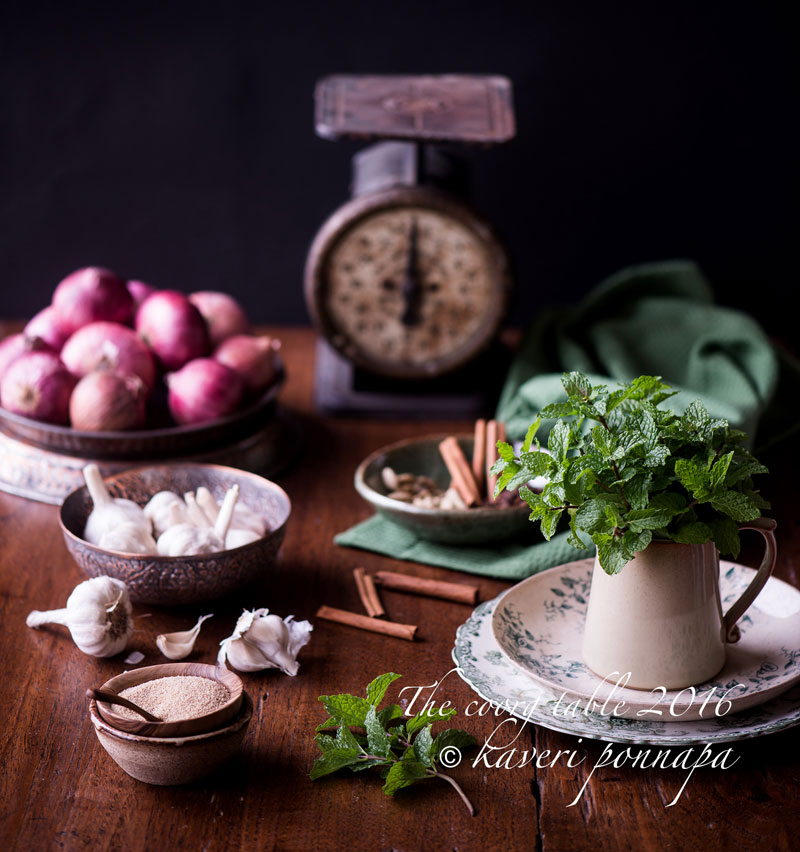 It is not a particularly elaborate dish, demanding innumerable, hard to procure ingredients or complex cooking techniques. But it needs careful, patient preparation and considerable skill in gauging cooking times to have that perfect, spice-scented, falling-off-the-bone meat and tender grains of rice at the end of several hours of work. Those were days when I would slip back into the kitchen by a side door that led into a small, messy room where the spice pastes were ground for the day’s cooking. The sturdy young woman who helped my grandmother in the kitchen would be at work on a pile of spices: tiny, undisciplined flecks of khas-khas; round, yellow moons of fried gram; spikes of deep scented cloves; green cardamom and sweet cassia bark. She would pound them into submission with the end of an elongated stone roller and then, gathering together bright white coconut scrapings, heaps of green leaves and garlic, she would begin to work rhythmically, lifting the roller ever so slightly, bringing it down with a ‘thunk’, and then moving it heavily and smoothly, forwards and backwards onto the ‘arpe kall’a grinding stone that was fixed into a waist-high concrete platform. She paused only fleetingly in this hypnotic movement to scoop up a little water from a ‘chembu’ she kept nearby, to add to the rapidly mingling spice paste. I would stand, watching intently. Soon a delicious green aroma, ripe with the decadence of garlic would fill the room. If I pleaded hard enough, when the spice paste was almost done, she would allow me to have a go at handling the roller and pretend that I was an expert grinder of spices. It was tricky work – the roller was heavy, with a will of its own, the surface of the stone slippery. If I had managed to crush one of my fingers, which was a distinct possibility, or had dropped the stone on my foot, she would have been in serious trouble. But such disasters never happened. Instead, I developed a lifelong love for hand-ground spice pastes, cool, smooth and always brightly coloured, never overheated and angry like their machine-ground counterparts. I loved the way she gathered the paste into a neat mound with the edge of her palm and then sprinkled just a little water to wash off what remained on the stone, scraping it into a dish with her hand. These carefully collected watery remnants were used in the cooking too, adding to the richness of the flavours. The spice paste held the secret to the fragrance and flavour of this particular pulao, blending all the different ingredients together so that they could not rush off on their own to confuse or dominate the palate, but had to yield up their qualities in a distinctive, beautifully layered harmony.
It is not a particularly elaborate dish, demanding innumerable, hard to procure ingredients or complex cooking techniques. But it needs careful, patient preparation and considerable skill in gauging cooking times to have that perfect, spice-scented, falling-off-the-bone meat and tender grains of rice at the end of several hours of work. Those were days when I would slip back into the kitchen by a side door that led into a small, messy room where the spice pastes were ground for the day’s cooking. The sturdy young woman who helped my grandmother in the kitchen would be at work on a pile of spices: tiny, undisciplined flecks of khas-khas; round, yellow moons of fried gram; spikes of deep scented cloves; green cardamom and sweet cassia bark. She would pound them into submission with the end of an elongated stone roller and then, gathering together bright white coconut scrapings, heaps of green leaves and garlic, she would begin to work rhythmically, lifting the roller ever so slightly, bringing it down with a ‘thunk’, and then moving it heavily and smoothly, forwards and backwards onto the ‘arpe kall’a grinding stone that was fixed into a waist-high concrete platform. She paused only fleetingly in this hypnotic movement to scoop up a little water from a ‘chembu’ she kept nearby, to add to the rapidly mingling spice paste. I would stand, watching intently. Soon a delicious green aroma, ripe with the decadence of garlic would fill the room. If I pleaded hard enough, when the spice paste was almost done, she would allow me to have a go at handling the roller and pretend that I was an expert grinder of spices. It was tricky work – the roller was heavy, with a will of its own, the surface of the stone slippery. If I had managed to crush one of my fingers, which was a distinct possibility, or had dropped the stone on my foot, she would have been in serious trouble. But such disasters never happened. Instead, I developed a lifelong love for hand-ground spice pastes, cool, smooth and always brightly coloured, never overheated and angry like their machine-ground counterparts. I loved the way she gathered the paste into a neat mound with the edge of her palm and then sprinkled just a little water to wash off what remained on the stone, scraping it into a dish with her hand. These carefully collected watery remnants were used in the cooking too, adding to the richness of the flavours. The spice paste held the secret to the fragrance and flavour of this particular pulao, blending all the different ingredients together so that they could not rush off on their own to confuse or dominate the palate, but had to yield up their qualities in a distinctive, beautifully layered harmony. 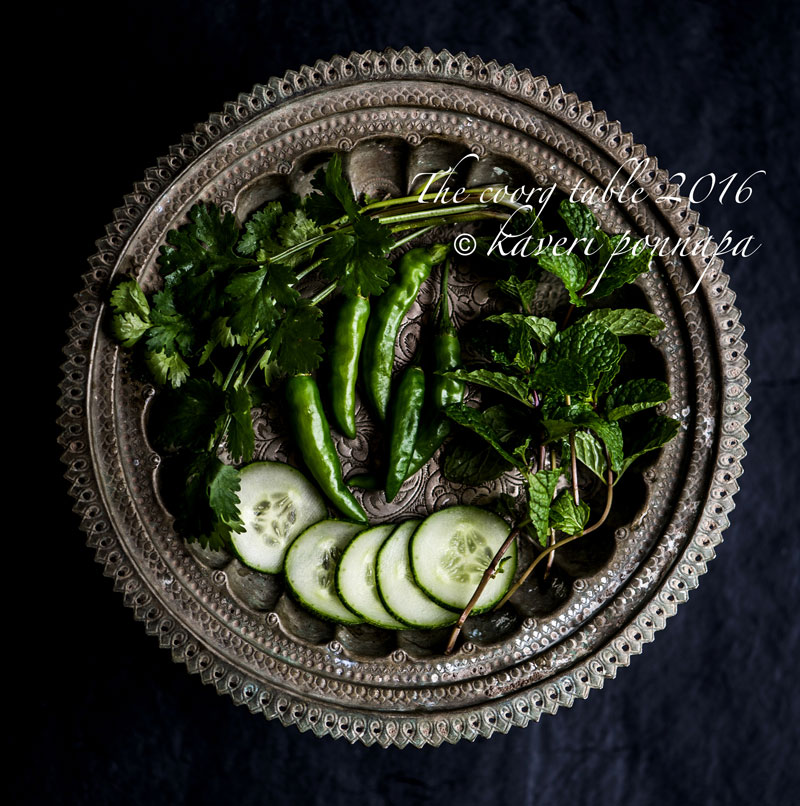 A morning’s dedicated slow-cooking would give you the most beautiful pulao. My grandmother used a large, heavy bottomed vessel, as did my mother-in-law, although I do have a pressure cooker version of her recipe, garnered from one of my aunts, years later. This is a true pulao, cooked in a rich stock. The favoured rice was not basmati, but the local, fragrant, short-grained jeerige sanna. All the flavours were sealed in with a square of cloth torn from a thin cotton Kerala towel and a lid placed over it all, a method that seems to have travelled without change with the original ‘pilaf’ from the Middle East on its journey East. The identical method of cooking this dish is described in Baghdadi and Syrian Arabic books: the cloth protects the steam from falling back on the rice and turning it to sticky mush. With this method, and some care, you have moist, plump, separate grains of rice that are the hallmark of a pulao.
A morning’s dedicated slow-cooking would give you the most beautiful pulao. My grandmother used a large, heavy bottomed vessel, as did my mother-in-law, although I do have a pressure cooker version of her recipe, garnered from one of my aunts, years later. This is a true pulao, cooked in a rich stock. The favoured rice was not basmati, but the local, fragrant, short-grained jeerige sanna. All the flavours were sealed in with a square of cloth torn from a thin cotton Kerala towel and a lid placed over it all, a method that seems to have travelled without change with the original ‘pilaf’ from the Middle East on its journey East. The identical method of cooking this dish is described in Baghdadi and Syrian Arabic books: the cloth protects the steam from falling back on the rice and turning it to sticky mush. With this method, and some care, you have moist, plump, separate grains of rice that are the hallmark of a pulao. 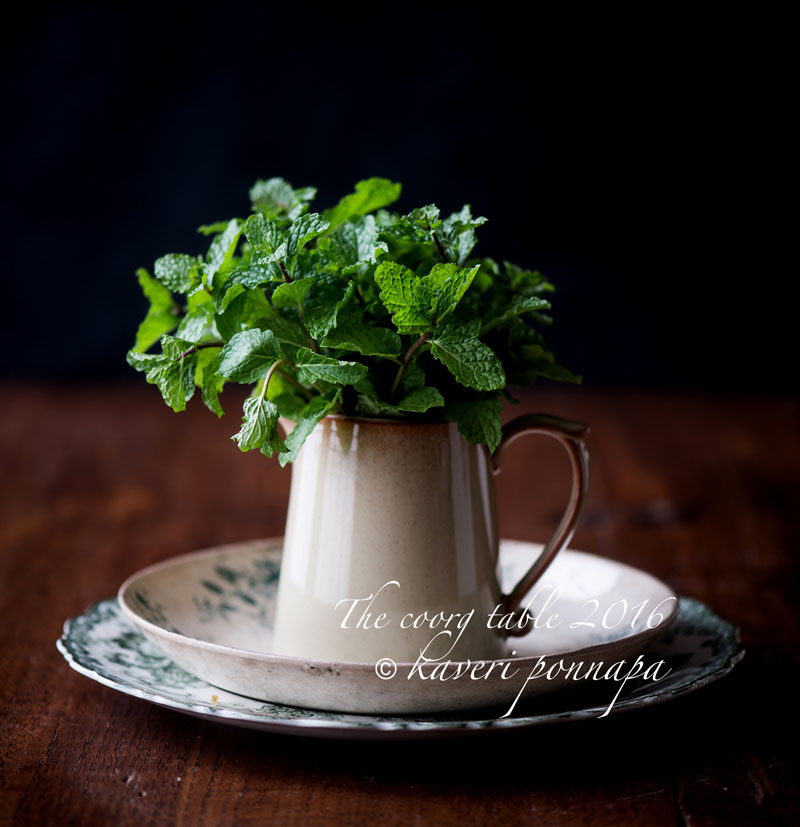 If you had judged when the rice had soaked just long enough to make it tender, and not soggy, and the meat was just right to add to the rice, the stock not too much, or too little to cook the rice, then, when you opened the lid of the vessel when the pulao was done, the most divine aroma would steal out, driving you crazy with impatience for lunchtime to come around. And my grandmother always got it right. We would dig our fingers into a soft pile of rice, sliding beautifully cooked chunks of meat off the bone, drawing some cool choute mor pajji, (cucumber pachadi) or fierce eruli mor pajji (onion pachadi) towards the rice, scooping everything into our mouths in bliss.
If you had judged when the rice had soaked just long enough to make it tender, and not soggy, and the meat was just right to add to the rice, the stock not too much, or too little to cook the rice, then, when you opened the lid of the vessel when the pulao was done, the most divine aroma would steal out, driving you crazy with impatience for lunchtime to come around. And my grandmother always got it right. We would dig our fingers into a soft pile of rice, sliding beautifully cooked chunks of meat off the bone, drawing some cool choute mor pajji, (cucumber pachadi) or fierce eruli mor pajji (onion pachadi) towards the rice, scooping everything into our mouths in bliss. 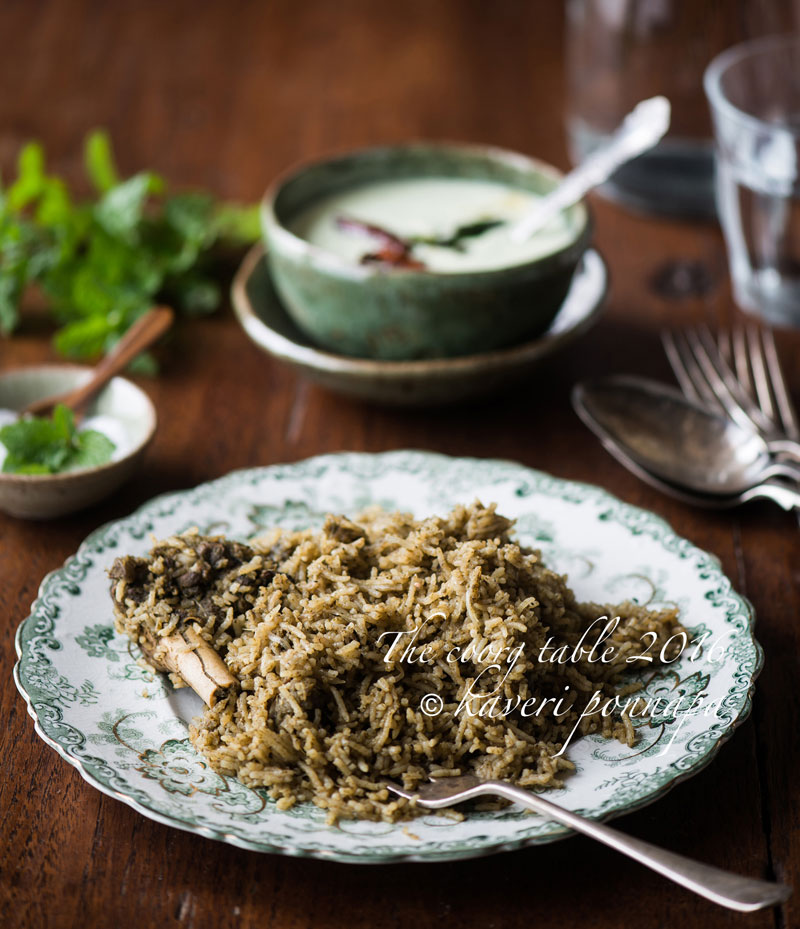 I love the way this dish has travelled so many thousands of miles from the kitchens where it was first invented, and following many less frequented paths of migration and trade, it has established itself in our rustic kitchens. With the use of local spices, it has acquired a character all its own – black peppercorns and Coorg’s unique kachampuli have worked their way into the flavourings quietly, seamlessly – and yet it retains something of its original identity. It also lent itself beautifully to the cooking of whole game birds, much prized at one time on the Coorg table, when every family used to hunt.
I love the way this dish has travelled so many thousands of miles from the kitchens where it was first invented, and following many less frequented paths of migration and trade, it has established itself in our rustic kitchens. With the use of local spices, it has acquired a character all its own – black peppercorns and Coorg’s unique kachampuli have worked their way into the flavourings quietly, seamlessly – and yet it retains something of its original identity. It also lent itself beautifully to the cooking of whole game birds, much prized at one time on the Coorg table, when every family used to hunt. 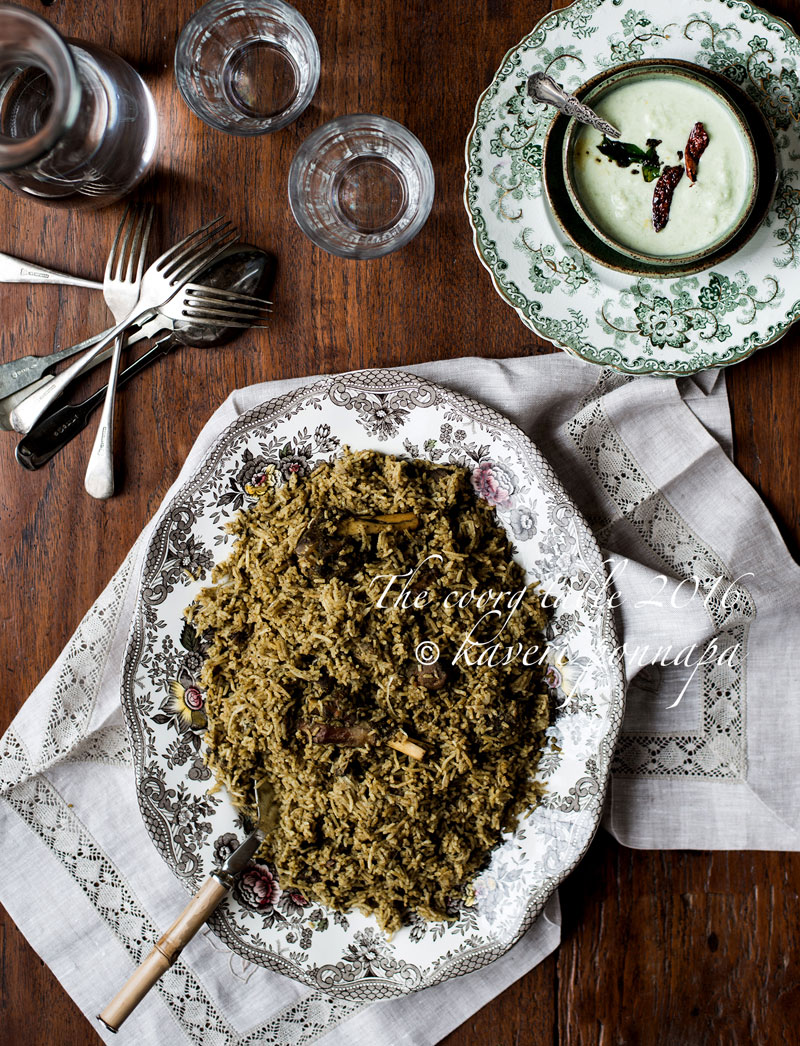
Erachi kool or kartha pulao is a dish that demands attention, and whenever it is served, it carries the unmistakable stamp of being something special. It used to be cooked and served at homes when guests arrived. At weddings, it was the most anticipated course, the colour of the rice making a darker, damper green on the gloss of the banana leaf on which it was served. It was eaten with silent concentration, a mor pajji of cucumber on the side that brought its own shade of green to the ones already before you, or sharp, crisp onions and green chilies in curd. Pulao is rich in flavor and character, a dish that demands much of the cook, that asks to be cherished – I now know why we were chased out of my grandmother’s kitchen all those years ago. It appears deceptively simple, until you have eaten it. It was a sad day when it was jostled off the table at Coorg weddings by a contender that came from the same region, the biryani – to my palate, it lacks the immense depth of a pulao.
Photo Credits: Nithin Sagi
All Food Styling: Kaveri Ponnapa
Please look out for this recipe in my upcoming cookbook.
Thank you for visiting this page. If you read something that you enjoy, or see an image that you like, please take a moment to write a response. Do look out for the recipes of all the food featured here in my upcoming cookbook.





What I wouldn’t give to bring back the erchi kool or erchi pulao instead of the Biryani that’s served at weddings. Also, the age old way of serving them on Banana leaves instead of melamine crockery that’s used now…I also remember..close relatives would serve guests at the weddings as opposed to stoic faces of caterers who do the needful now. Lacking any personal touch and familiarity that would once be so important.
Hello Saroja, welcome back! I guess it’s part nostalgia, part common sense that keeps us hoping for a slower pace of life, where human interaction was a significant part of the enjoyment of food and eating.Personally, I would opt for a much smaller number of guests, and more mingling, at any such occasion. But I think I’m outnumbered, at least right now. Who knows how things may change after the events we are experiencing right now? Warmest wishes. Kaveri.
There’s just something special about the way anything that’s hand-ground on the stone, tastes. This takes me back to the warmth of the hands and not the blades of the mixer. The way the paste was carefully scraped and the sprinkling of just enough water to take the remaining masala onto the plate and used well. Incorporating both variants well into the dish, thick masala first and then using the watery remnants. My grandmother made chutneys, ground masala for pulao, curries, vegetable dishes etc etc on the grinding stone, oh so effortlessly. This took me back straight into her kitchen when we kids were shooed away from the ‘Sunday kitchen’ when she made Mutton pulao. Now when I’m trying it at home, I realise why. Precision is everything of course the hand, grinding stone and everything else counts just as much too.
Much love to you.
There’s a lot to be said for grinding spices on stone, Saroja, and since you’ve had the experience of watching the process, I’m not surprised that you are now grinding spices the old fashioned (and hard!) way in your kitchen. It’s well worth the effort, as you know, everything looks, smells and tastes different. I often wish that I had the time to do the spice pastes this way every single day – but I’m not doing too badly! Thank you for reading, and for having taken the time to write. Warm wishes.Kaveri
Hi Kaveri, I’m waiting for your book!
Hello Srini! It’s a work in progress, I hope that you won’t have to wait too long. There are some very nice recipes and stories going into it. Kaveri
Dear Kaveri, There is something about your blending of authenticity, skill, artform and literature … just like the perfect masala blend for a great dish , which elevates your recipe so much more… My first time browsing… I almost felt a wisp of aroma as I read and re- read this recipe… I enjoyed the narrative supremely making cooking more a journey than the destination. Looking forward to creating this recipe.
Hello Kasturi, welcome to these pages, and thank you very much for all your wonderful thoughts about The Coorg Table. This pulao always brings back vivid taste memories and more, for me, personally-I am so happy that you shared them too. Please do keep reading,I hope you will enjoy all the posts as much as this one. The recipes will be coming along in a book, I will keep you posted. Meanwhile, there are some up on the blog that you may like to try out.Warm wishes. Kaveri
I really love your recipe I love peppery and spicy food I love coorg recipes
Hello Reshma, thank you for visiting The Coorg Table. We do have some of the most interesting and delicious cuisine around, and I will be adding more to these pages whenever possible. In the meanwhile, do read the other posts, and look out for the cookbook, which will have all the recipes that you enjoy. Best wishes.Kaveri
Hi Kaveri Ponnapa..
I just went through your page yesterday while scrolling down on Facebook.. since I’m a big time food lover And love cooking , my eyes caught ur page..
I must really put it here that, when we have these wonderful recipes vanishing day by day ,saving them here in your blog/page is an great idea..
It took me back to my childhood which I spent eating Muddre kanni,Mange curry and many such delicious,delicate Nd deriving to eat type of food from my lovely avya’s(grandmother) kitchen ..
It’s an great idea of having it all together here.. Your recipes, pictures and every bit of your page is so mesmerising ,thoughtful and wonderfully stated..
Thank you for this “taking back” thoughts and wonderfully stated recipes.. looking for more to come..
I cooked this last night and I knew there was something amiss from the aroma. Again, your posts always reminds me of my grandma’s cooking, authentic Kodava food and not just the food the fond memories of once that was. Eagerly awaiting your book 🙂
Hi Pancham, welcome to The Coorg Table! What you say is absolutely true- the food is woven into memories that take us back to a place that no longer exists. Every time that happens, I think, how lucky we were to have been in that place, at just that time. And yes, sometimes we forget some crucial detail in a dish, and it does not taste the same-I hope that my book will help fill in the gaps, in addtition to decades of cooking,I have been collecting stories, experiences and recipes for quite a while. Thank you for sharing your thoughts, do keep reading and writing in. Best wishes. Kaveri
Wow nice! Even though I don’t eat non-veg, I do like to prepare erachi pulaov and once serve to my parents and cousins. Am eagerly waiting for your cook book….Good luck….
Hi Kaverappa, this is such a fabulous, old-style dish, I am sure that everyone in your family will love it. Thank you very much for your good wishes. Kaveri
Best wishes for your CookBook. Loved the story here. Beautiful photo and styling. And I envy your props. 😀
Thank you very much for your good wishes, Chandrima, and I am so glad you liked the story. The food pictures are a passion, and it’s alway nice when they tell your story the way you hope that they will. Your blog is lovely too, and that Bengali Mutton Curry/Mangshor Jhol you have posted looks stunning! I love the meat and potatoes combination, and will be trying your recipe out soon. Do keep reading! Warm wishes.Kaveri
Ufff looks yummy👌 my favorite dish…
Hi Kushalappa, I have to say it was really delicious. Ate with chouthe mor pajji this time! Have a great weekend, hope you enjoy some erachi pulao! Kaveri